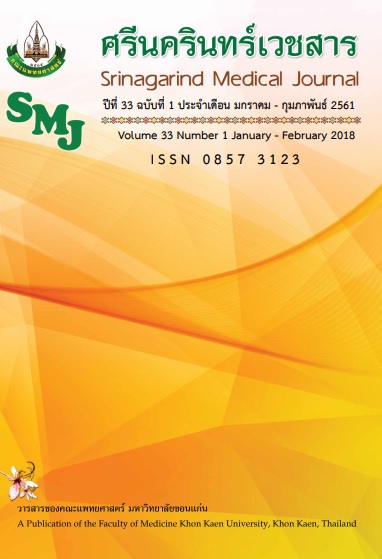Effect of Bacteriophage 365A Against Ceftazidime Resistant Burkholderia pseudomallei in Planktonic and Biofilm conditions
Keywords:
Burkholderia pseudomallei; ceftazidime resistant; bacteriophage; biofilm Burkholderia pseudomallei; ดื้อยาเซฟตาซิดิม; แบคเทอริโอเฟจ; ไบโอฟิล์มAbstract
Background and Objective: Burkholderia pseudomallei is a Gram negative bacilli bacteria that causes melioidosis. The endemic areas are in Northern Australia and Northeastern Thailand. Currently, bacteria resistance to many antibiotics, including ceftazidime, the drug of choice to treat melioidosis. This study investigated the characteristics and capabilities of bacteriophage isolated from B. pseudomallei to kill and reduce biofilm formation in ceftazidime resistant B. pseudomallei.
Methods: The bacteriophage was spontaneously isolated from B. pseudomallei 365A. It was characterized the structure by transmission electron microscope and identified nucleic acid type. Host range determination of bacteriophage was performed by spot test. Capability of bacteriophage to kill and reduce biofilm formation in ceftazidime resistant B. pseudomallei was performed by time kill assay and colorimetric method, respectively
Results: Bacteriophage 365A structure composed of icosahedral head and contractile tail with tail fibers. It had DNA as a genetic material, thus it belongs to Myoviridae family. Bacteriophage 365A was able to lysed 100% of ceftazidime resistant B. pseudomallei tested isolates. Bacteriophage 365A also reduced 2 log units of ceftazidime resistant B. pseudomallei in planktonic conditions and reduced 60-68% of biofilm formation.
Conclusion: Bacteriophage 365A isolated from B. pseudomallei strain 365A has potential to reduce ceftazidime resistant B. pseudomallei in planktonic conditions and can also reduce biofilm formation. According to efficiency of bacteriophages 365A, it may possibly use bacteriophage 365A to control ceftazidime resistant B. pseudomallei.
ผลของแบคเทอริโอเฟจ 365A ในการยับยั้งเชื้อ Burkholderia pseudomallei ที่ดื้อต่อยาเซฟตาซิดิมในสภาวะแพลงโทนิคและสร้างไบโอฟิล์ม
นัยพัช นิตยสุทธิ์, อุมาพร ยอดประทุม*
1ภาควิชาจุลชีววิทยา 2ศูนย์วิจัยโรคเมลิออยโดสิส คณะแพทยศาสตร์ มหาวิทยาลัยขอนแก่น
หลักการและวัตถุประสงค์: Burkholderia pseudomallei เป็นแบคทีเรียแกรมลบรูปแท่ง ที่เป็นสาเหตุของโรคเมลิออยโดสิส พบระบาดมากทางตอนเหนือของประเทศออสเตรเลียและภาคตะวันออกเฉียงเหนือของไทย เชื้อดื้อต่อยาปฏิชีวนะหลายชนิดรวมถึงยาเซฟตาซิดิม ซึ่งเป็นยาที่ใช้ในการรักษาโรค วัตถุประสงค์ของการวิจัยนี้เพื่อศึกษาลักษณะและความสามารถของแบคเทอริโอเฟจที่แยกได้จากเชื้อ B. pseudomallei ในการทำลายเชื้อและไบโอฟิลม์ของเชื้อ B. pseudomallei ที่ดื้อยาเซฟตาซิดิม
วิธีการศึกษา: คัดแยกและศึกษาโครงสร้างของแบคเทอริโอเฟจภายใต้กล้องจุลทรรศน์แบบส่องผ่าน ศึกษาชนิดสารพันธุกรรม ทดสอบความสามารถในการติดเชื้อแบคทีเรีย ด้วยวิธี spot test ทดสอบความสามารถของแบคเทอริโอเฟจในการยับยั้งเชื้อ B. pseudomallei ที่ดื้อต่อยาเซฟตาซิดิม ด้วยวิธี time kill assay รวมถึงการยับยั้งการสร้างไบโอฟิล์มของเชื้อ B. pseudomallei ที่ดื้อต่อยาเซฟตาซิดิม ด้วยวิธีการ colorimetric method
ผลการศึกษา: โครงสร้างของแบคเทอริโอเฟจ 365A ประกอบด้วยหัวรูปทรงหลายเหลี่ยมและหางที่ยืดหดได้ และมีดีเอ็นเอเป็นสารพันธุกรรม จึงจัดอยู่ใน family Myoviridae ความสามารถในการเข้าทำลายเชื้อ B. pseudomallei ที่ดื้อต่อยาเซฟตาซิดิม ได้ร้อยละ 100 เปอร์เซ็นต์ (5 สายพันธุ์) นอกจากนี้ยังสามารถลดปริมาณเชื้อ B. pseudomallei ที่ดื้อยาเซฟตาซิดิม ในสภาวะแพลงโทนิกได้ 2 log units และลดการสร้างไบโอฟิลม์ของเชื้อ B. pseudomallei ที่ดื้อยาเซฟตาซิดิมได้ร้อยละ 60-68
สรุป: แบคเทอริโอเฟจ 365A ที่แยกได้จาก B. pseudomallei สายพันธุ์ 365A มีความสามารถในการลดปริมาณเชื้อ B. pseudomallei ที่ดื้อยาเซฟตาซิดิมในสภาวะแพลงโทนิกและลดการสร้างไบโอฟิลม์ได้ จึงอาจเป็นทางเลือกใหม่ที่จะนำแบคเทอริโอเฟจ 365A มาประยุกต์ใช้ในการควบคุมเชื้อ B. pseudomallei ที่ดื้อยาเซฟตาซิดิมในอนาคต




